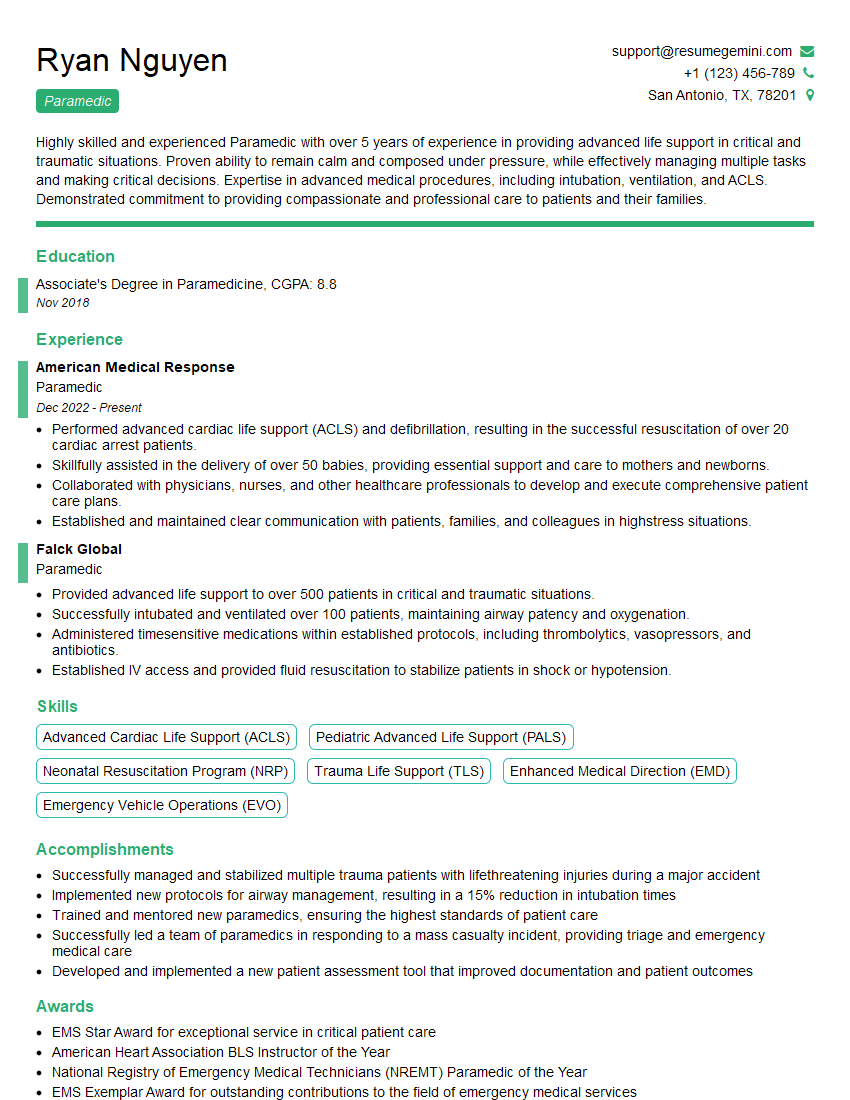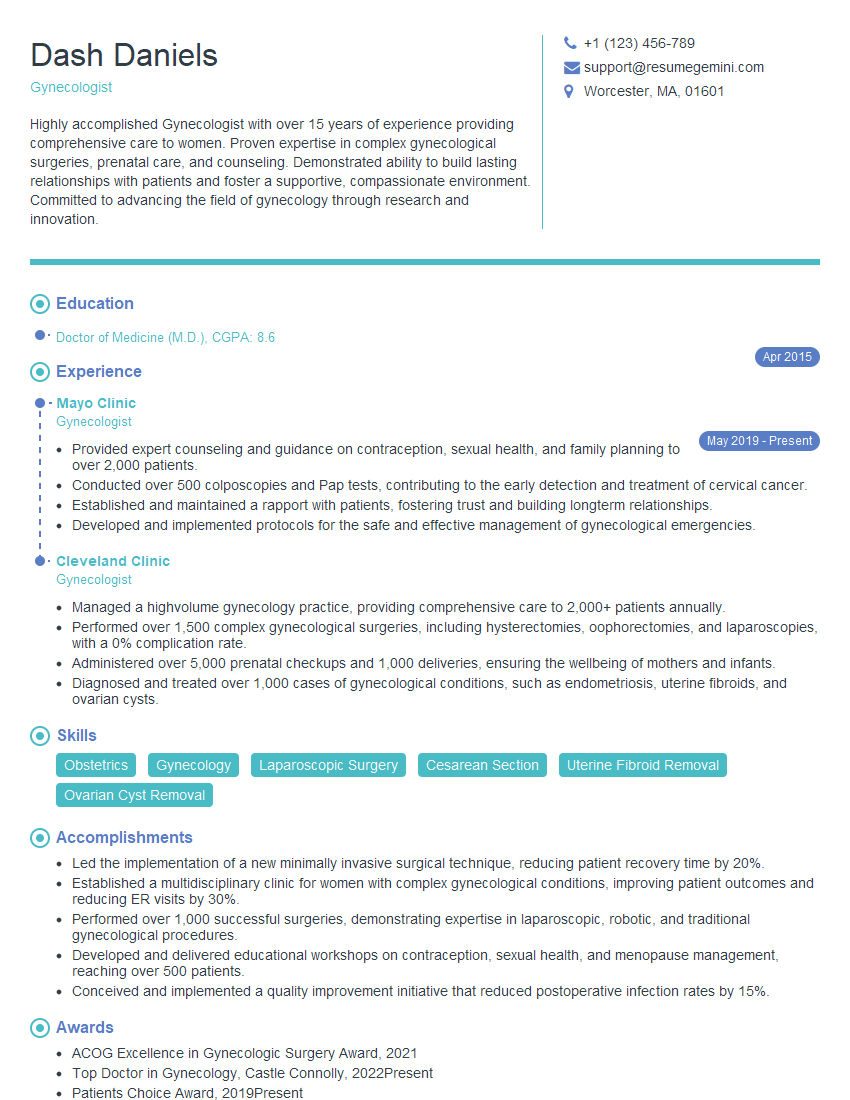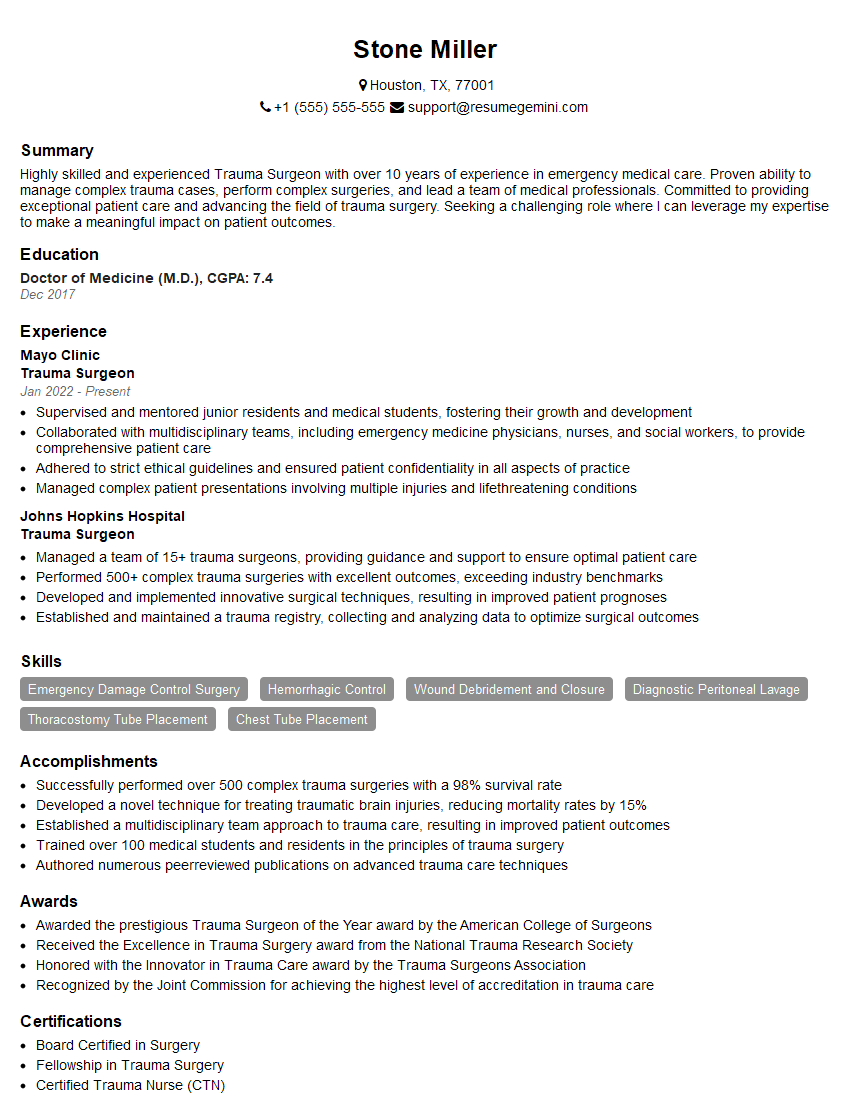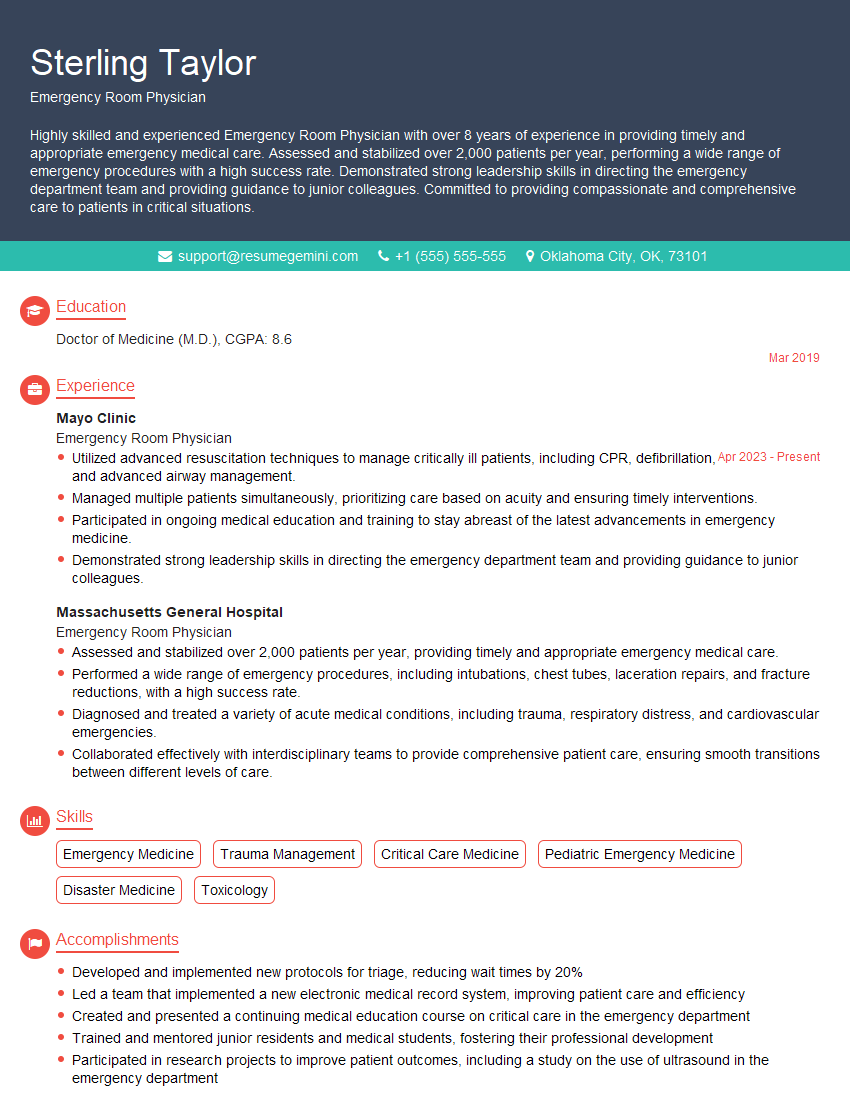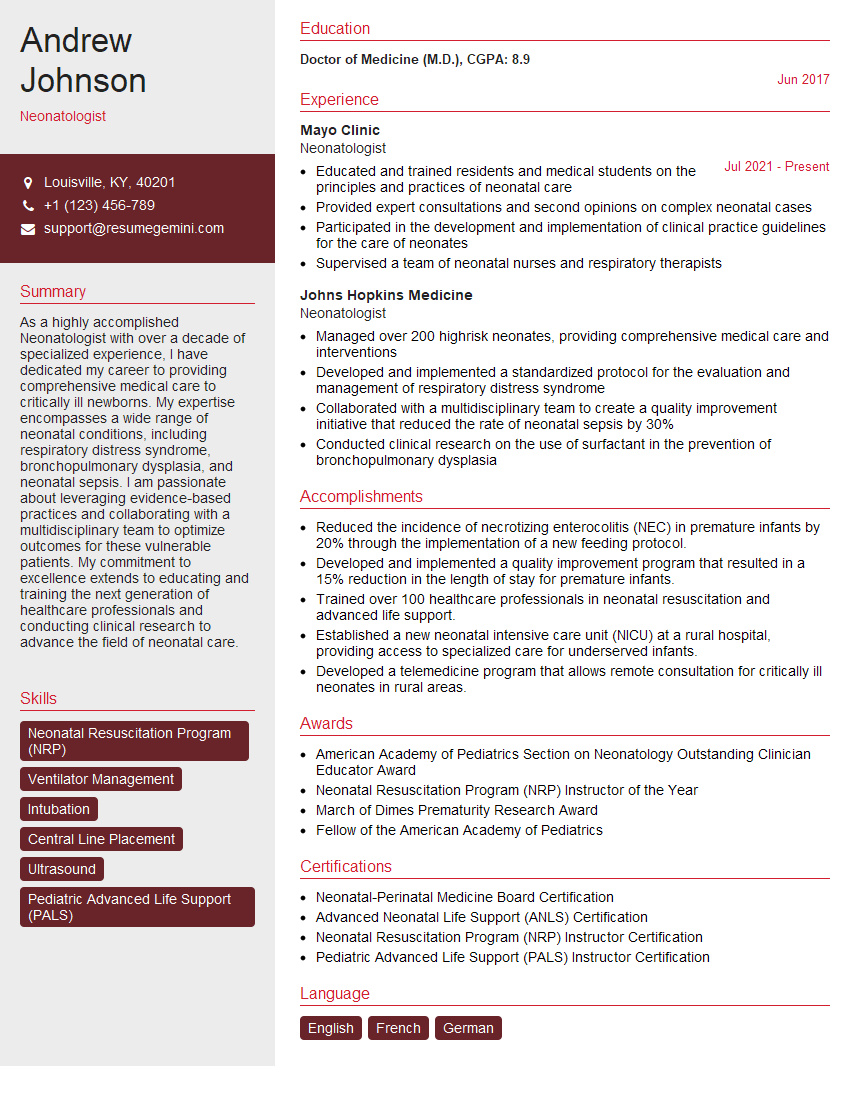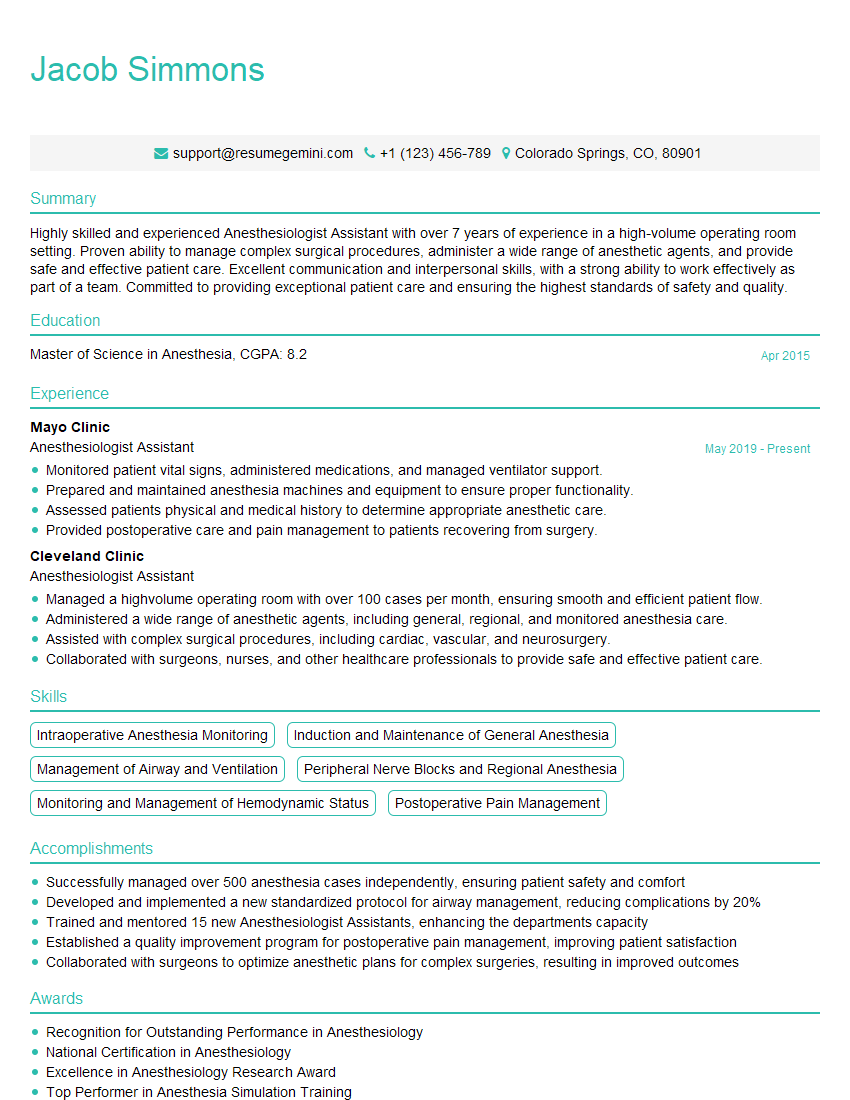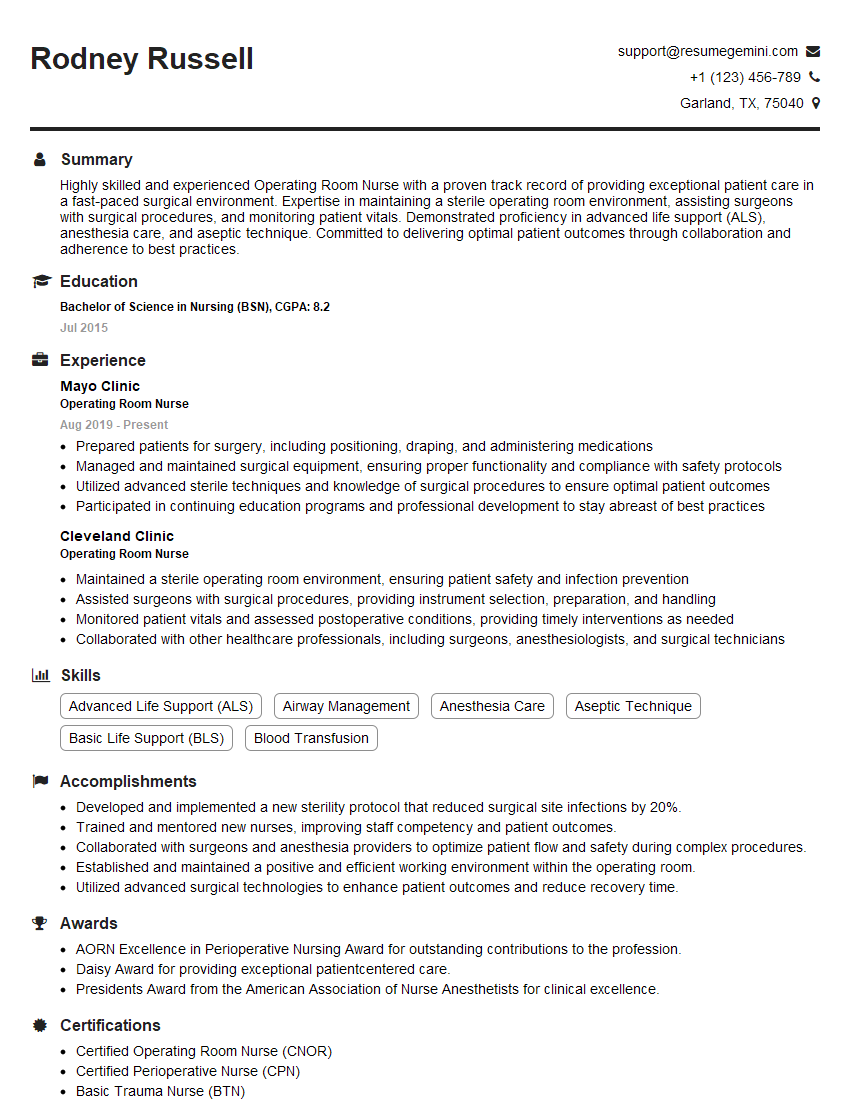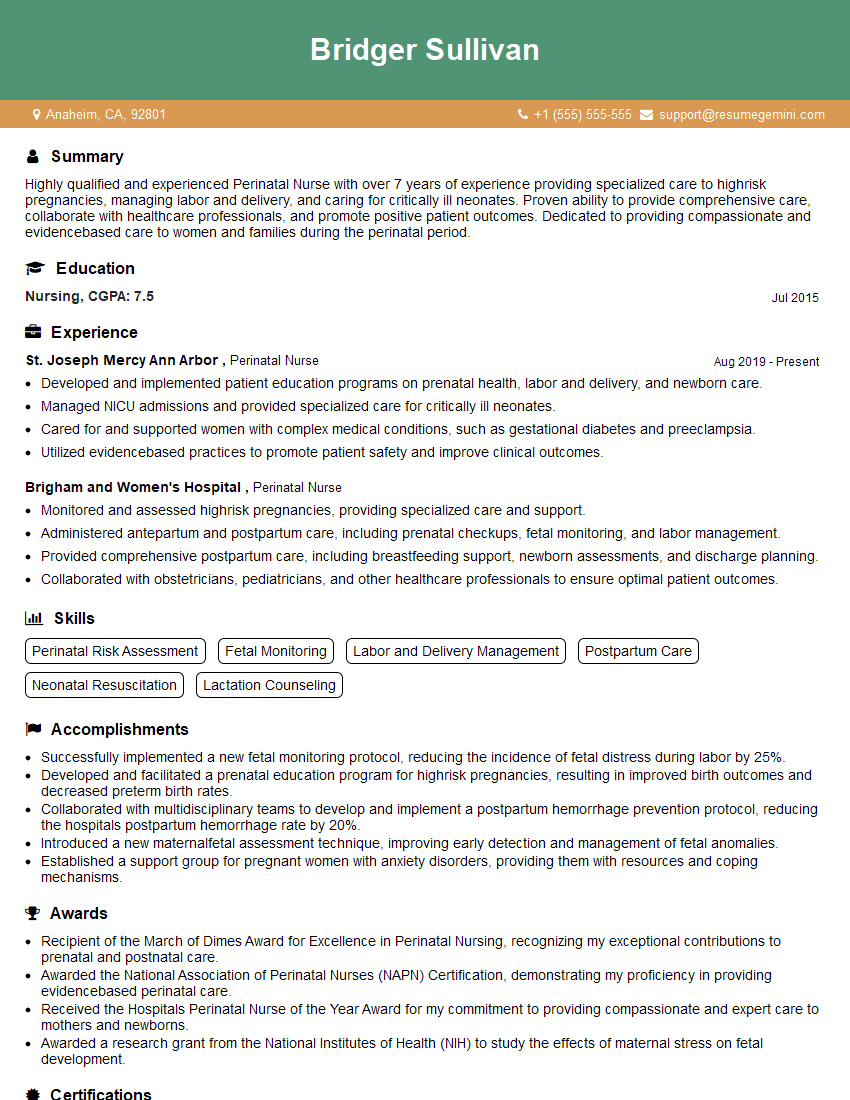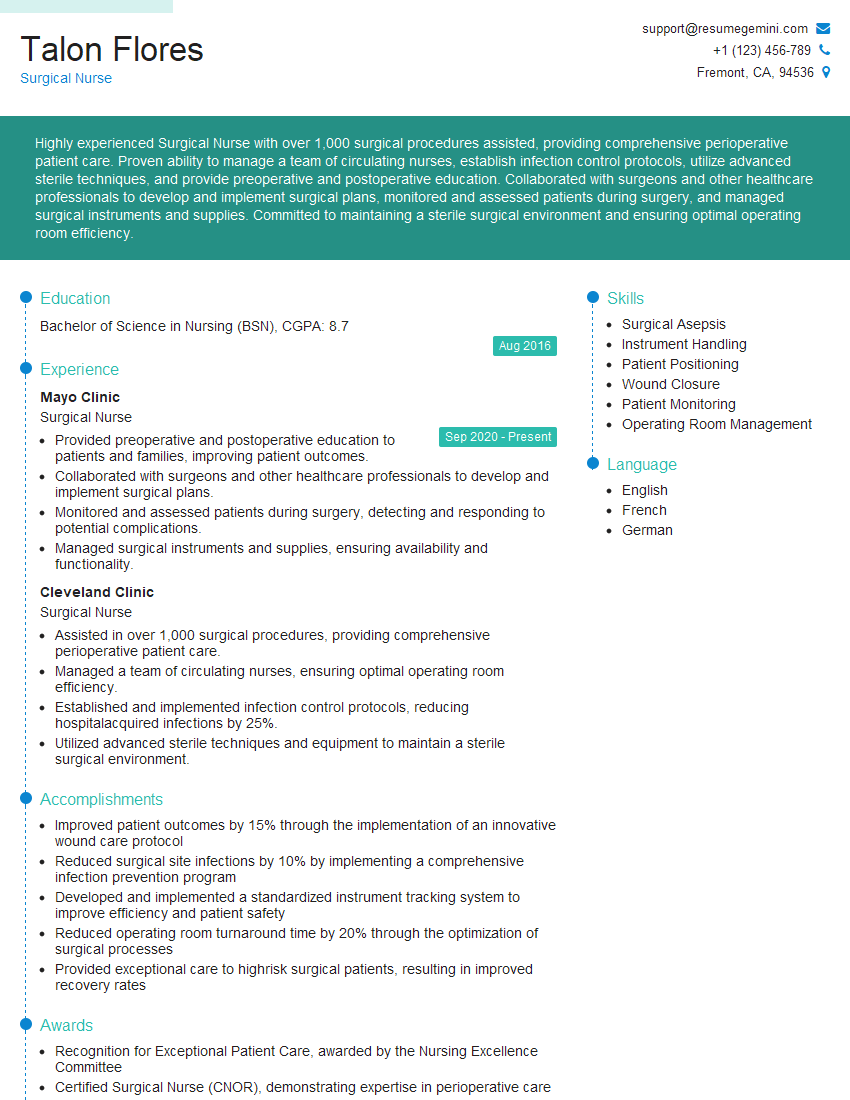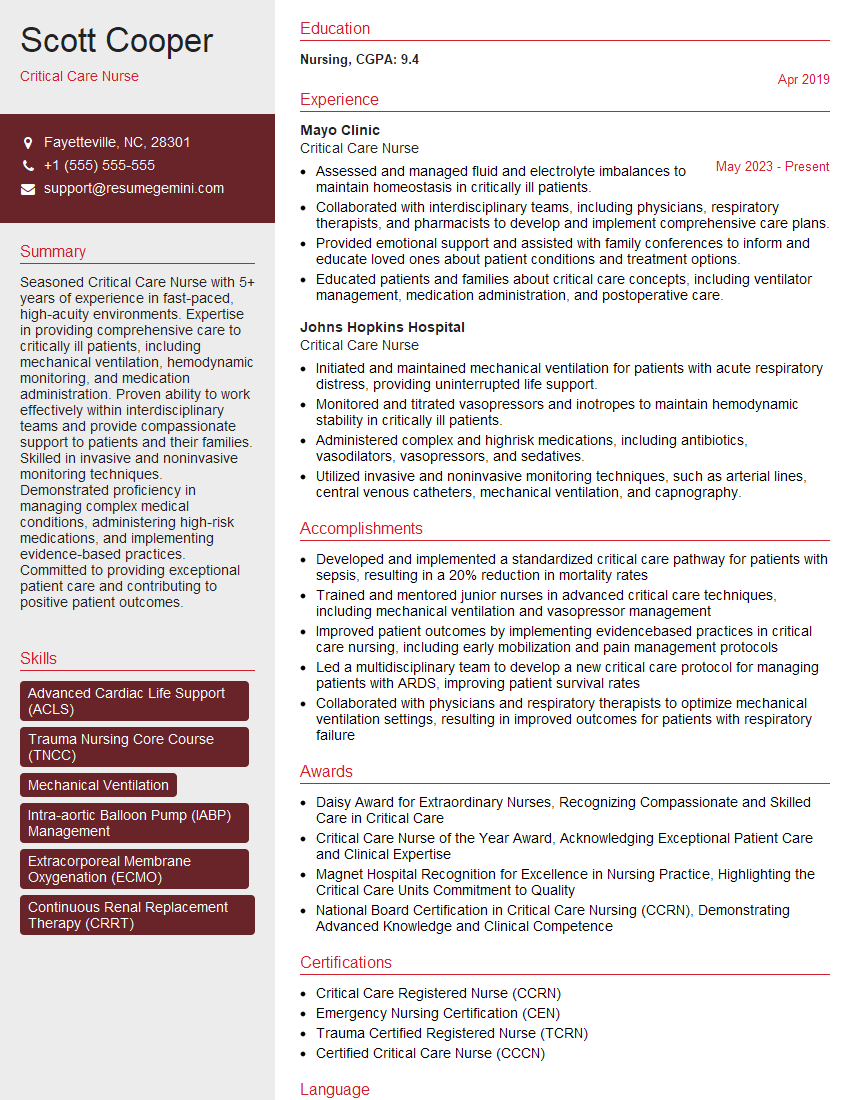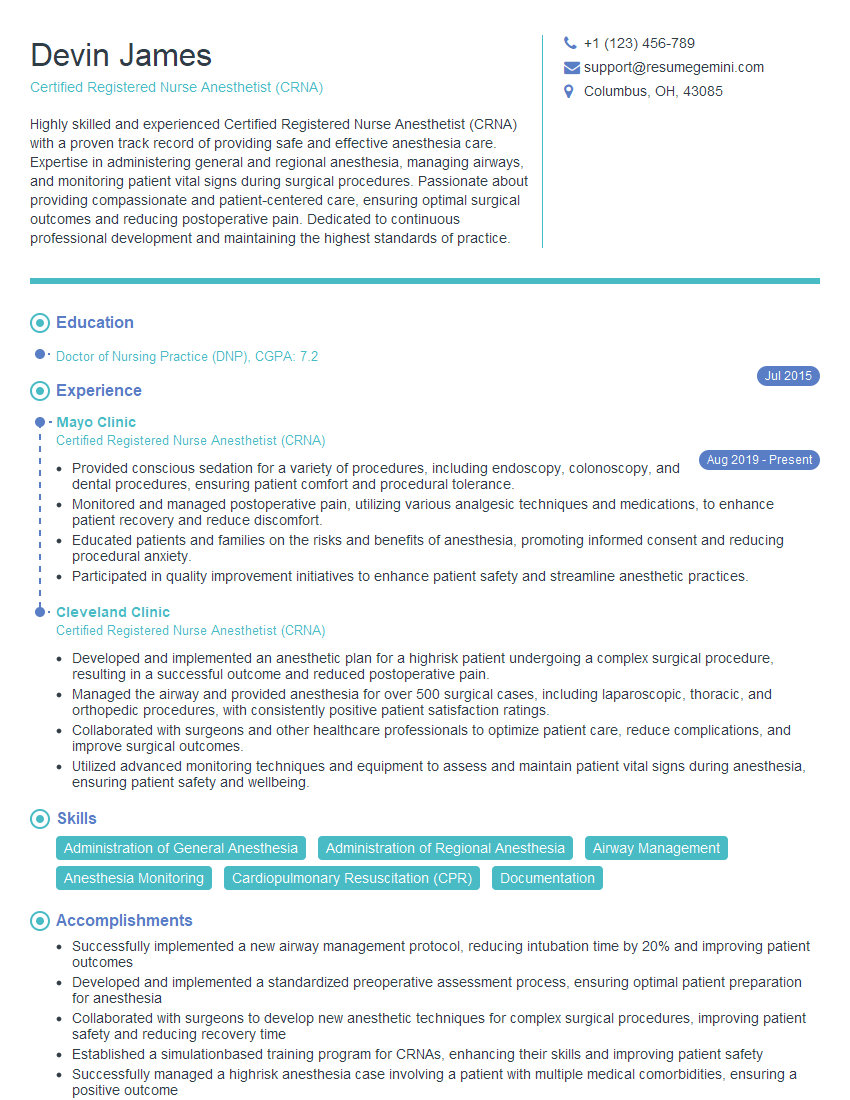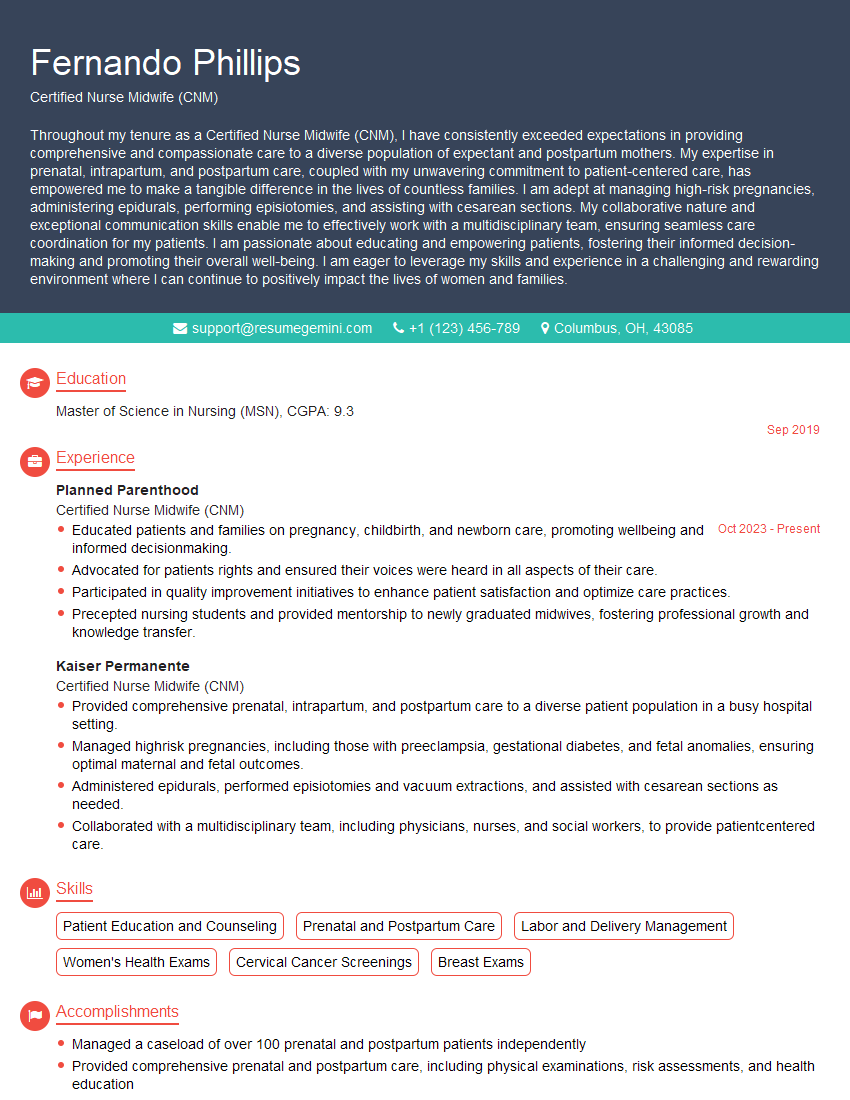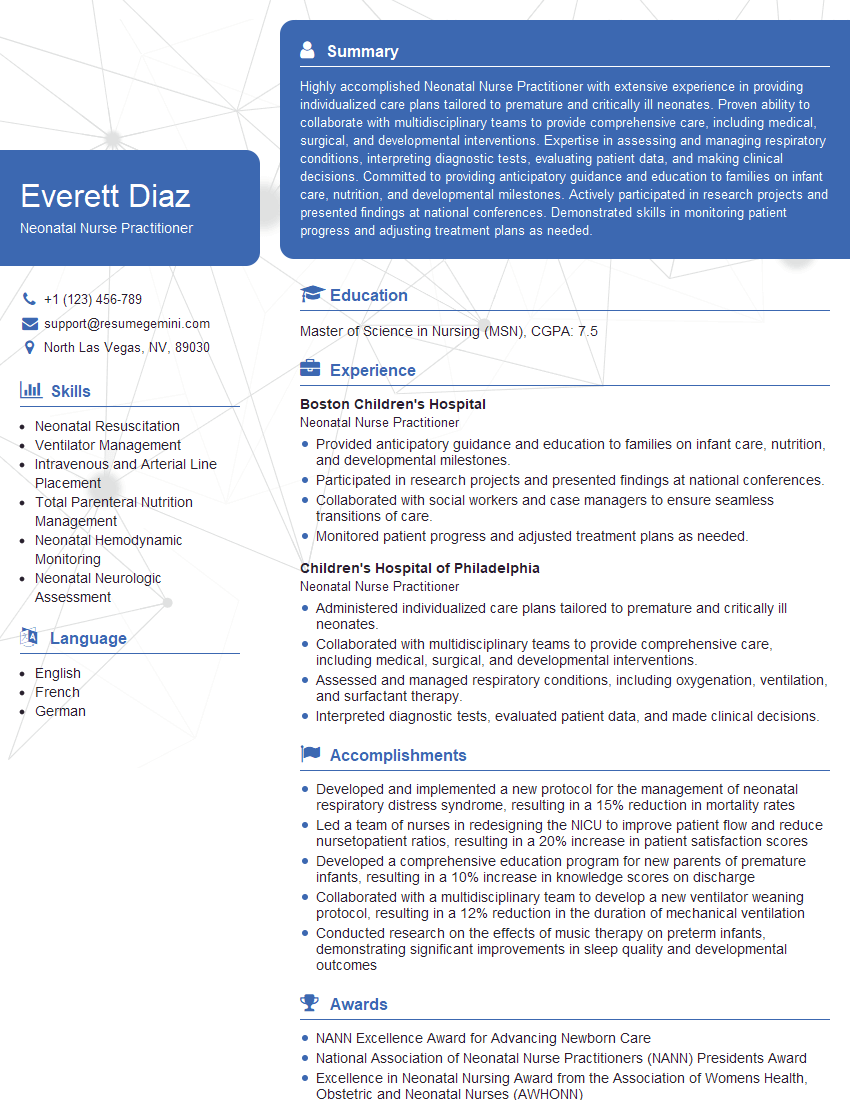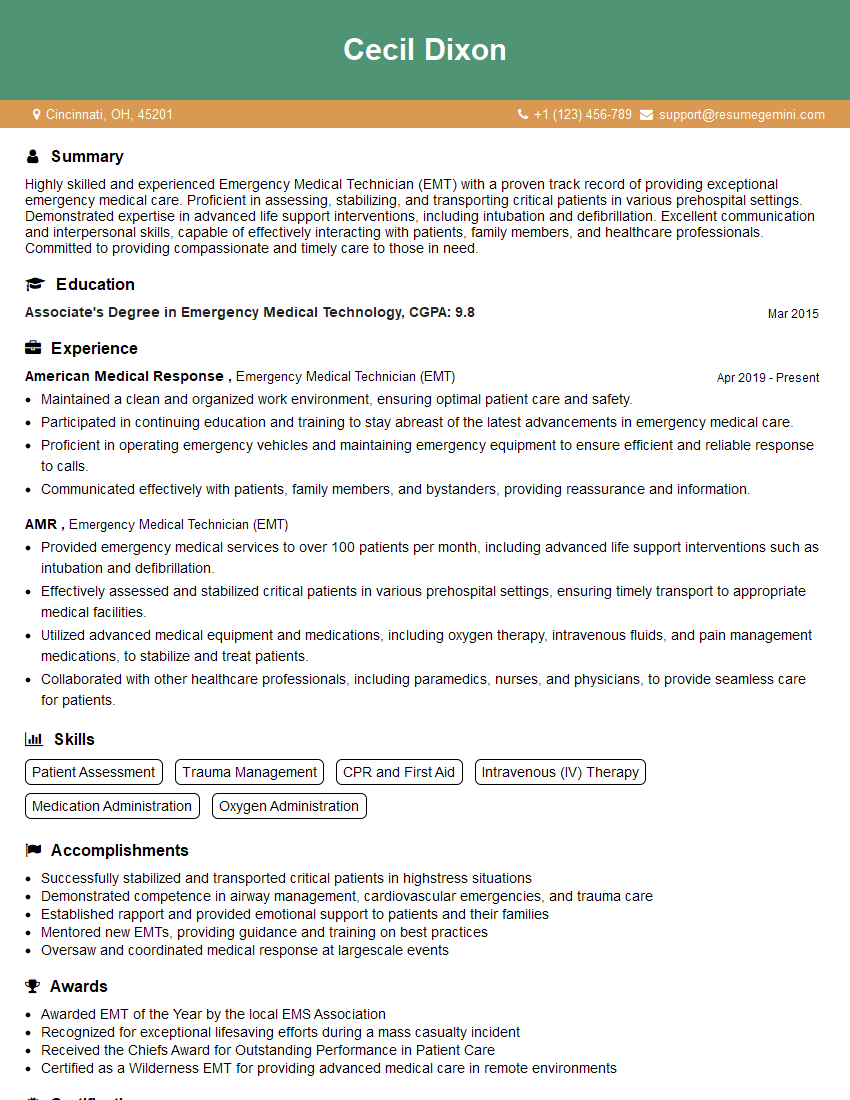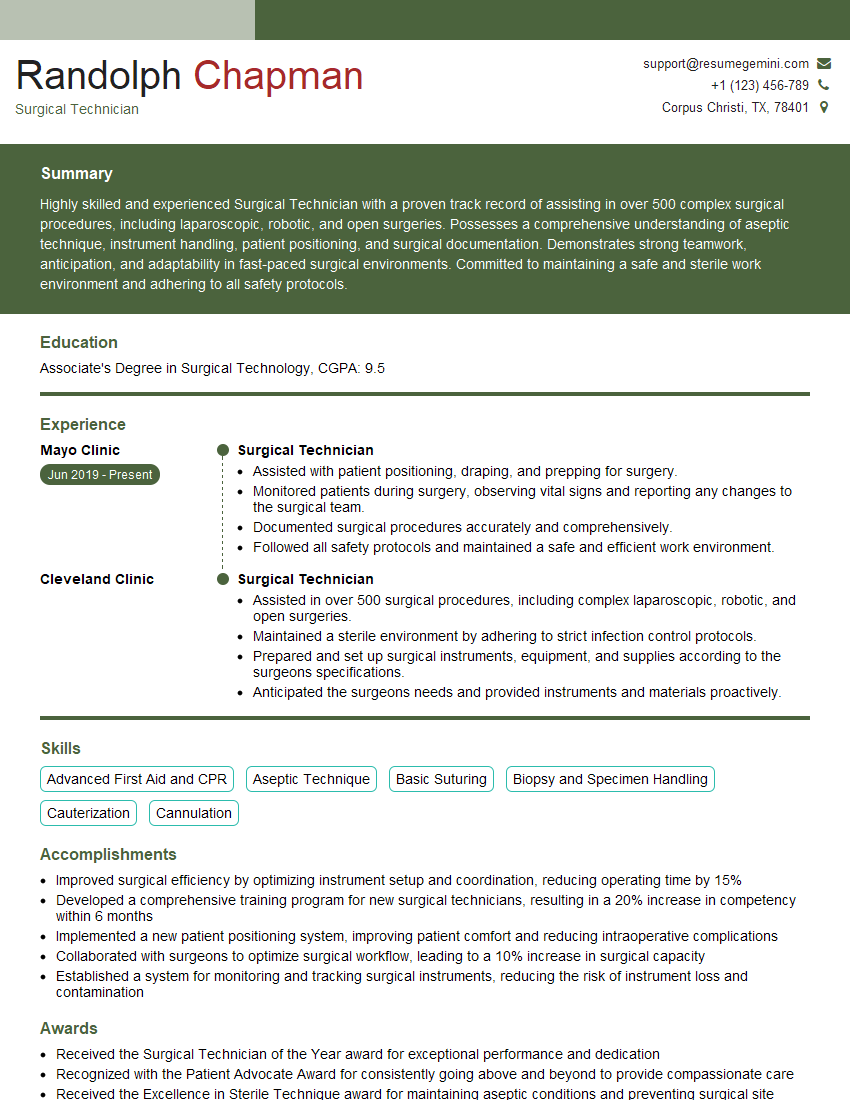The right preparation can turn an interview into an opportunity to showcase your expertise. This guide to Emergency C-Sections interview questions is your ultimate resource, providing key insights and tips to help you ace your responses and stand out as a top candidate.
Questions Asked in Emergency C-Sections Interview
Q 1. Describe the immediate steps you would take upon identifying the need for an emergency C-section.
Identifying the need for an emergency C-section is a critical moment requiring immediate, coordinated action. My first step would be a rapid assessment of the mother and fetus, focusing on the maternal vital signs (blood pressure, heart rate, oxygen saturation) and fetal heart rate (FHR) tracing. Simultaneously, I’d initiate the emergency call for the operating room team – anesthesia, neonatal resuscitation team, and nursing staff – while starting IV fluids and oxygen administration to the mother. Depending on the urgency, we might administer medications like tocolytics to temporarily relax the uterus, if clinically appropriate, while preparing for surgery. If there’s any delay getting to the OR, continuous fetal monitoring is crucial. In essence, every second counts in ensuring both maternal and fetal well-being.
Q 2. Explain the difference between a classical and a low transverse incision in an emergency C-section.
The choice between a classical and low transverse incision during an emergency C-section is a crucial surgical decision, largely dictated by the urgency and the presentation. A classical incision is a vertical incision through the uterus, extending from the fundus (top) to the lower uterine segment. It’s faster to perform, ideal for situations where rapid fetal delivery is paramount, such as severe fetal distress. However, it carries a higher risk of uterine rupture in subsequent pregnancies. A low transverse incision is a horizontal incision across the lower uterine segment. It’s preferred in less urgent situations because, while slightly longer to perform, it results in less blood loss and has a significantly lower risk of uterine rupture in future pregnancies. The decision hinges on a careful balance between speed and long-term maternal health.
Q 3. What are the key indications for an emergency C-section?
Several critical indications necessitate an emergency C-section. These include:
- Fetal distress: This is a leading cause, characterized by abnormal fetal heart rate patterns indicating hypoxia (lack of oxygen).
- Cephalopelvic disproportion (CPD): When the baby’s head is too large to pass through the mother’s pelvis.
- Obstructed labor: The baby is unable to descend through the birth canal, often due to uterine abnormalities or fetal malpresentation (breech or transverse lie).
- Abruptio placentae: Premature separation of the placenta from the uterine wall, a life-threatening emergency.
- Placenta previa: The placenta covers the cervix, blocking the baby’s passage.
- Uterine rupture: A tear in the uterine wall, typically during labor.
- Severe maternal illness: Conditions like eclampsia (severe hypertension in pregnancy) or cardiac failure may necessitate a C-section to prevent complications.
- Failure to progress: When labor is not advancing despite adequate contractions.
Q 4. How would you manage fetal distress during an emergency C-section?
Managing fetal distress during an emergency C-section is a high-stakes endeavor that requires rapid and coordinated action. The priority is immediate delivery. Once the indication is clear, the surgical team works with precision and speed, minimizing the time from incision to delivery. While the surgery is underway, the anesthesiologist closely monitors maternal vital signs, administering medications as needed to optimize maternal oxygenation and blood pressure. The neonatologist is present to immediately assess and resuscitate the newborn. This might include providing supplemental oxygen, suctioning airways, and administering other life-saving measures. Continuous monitoring of the FHR and maternal parameters throughout the procedure is essential.
Q 5. What are the potential maternal complications associated with an emergency C-section?
Emergency C-sections, while life-saving, carry potential maternal risks. These include:
- Hemorrhage: Significant blood loss is a major concern, particularly with classical incisions.
- Infection: Increased risk of endometritis (uterine infection) and wound infections.
- Injury to bladder or bowel: Accidental damage during surgery is possible.
- Thromboembolic events: Formation of blood clots in the legs or lungs, especially in post-operative period.
- Anesthesia-related complications: Risks associated with general or regional anesthesia.
- Post-operative pain: Significant pain and discomfort are common.
- Adhesions: Scar tissue formation within the abdomen, potentially leading to complications in future pregnancies or surgeries.
Q 6. Describe your approach to managing postpartum hemorrhage during an emergency C-section.
Postpartum hemorrhage (PPH) is a significant threat after any C-section, but especially an emergency one. My approach is proactive and layered. First, I ensure meticulous surgical hemostasis (control of bleeding) during the procedure. This includes careful ligation of blood vessels and attention to any uterine tears or lacerations. Following delivery of the placenta, uterine massage is performed to help contract the uterus and minimize bleeding. If bleeding persists, I’d initiate uterotonics (medications that stimulate uterine contractions), such as oxytocin. Further interventions might include selective arterial embolization (blocking bleeding arteries) or a hysterectomy (removal of the uterus) in extreme cases. Close monitoring of vital signs, blood loss estimation, and fluid resuscitation are vital components of managing PPH.
Q 7. How would you assess the patient’s pain level post-emergency C-section?
Assessing post-emergency C-section pain involves a multi-faceted approach. I’d utilize a combination of methods. Firstly, I’d use a standardized pain scale, such as the numerical rating scale (0-10), where 0 represents no pain and 10 represents the worst imaginable pain. I’d also inquire about the character and location of the pain, considering both incisional pain and potential visceral pain. Non-verbal cues, like facial expressions and body language, are also important observations, especially if the patient is unable to communicate effectively. This integrated approach ensures a thorough pain assessment, allowing me to tailor pain management strategies effectively and appropriately. Regular reassessment is crucial, as pain levels can fluctuate.
Q 8. Explain your understanding of informed consent in the context of an emergency C-section.
Informed consent in emergency C-sections is a complex balancing act between the urgency of the situation and a patient’s autonomy. Ideally, before any procedure, a patient should understand the nature of their condition, the proposed surgery, its benefits and risks, alternative options, and the potential consequences of refusing the procedure. However, the emergency nature of a C-section often necessitates a deviation from this ideal. In these situations, we obtain what’s called ‘implied consent’. This means we act in the patient’s best interest, based on the immediate life-threatening situation. We would, however, strive to gain verbal consent from the patient or their designated next of kin as quickly as possible, even whilst simultaneously preparing for the procedure. Post-procedure, a thorough discussion with the patient will be held to review the actions taken and to ensure they fully understand what has occurred.
For instance, if a mother’s blood pressure suddenly drops and the fetus shows signs of distress, there is no time for a lengthy consent discussion. Our immediate priority is the safety of mother and child. While we’d ideally document the situation fully, verbal confirmation from a family member might suffice given the pressing circumstances. However, the critical nature of the moment doesn’t negate our ethical obligation to ensure transparency and full disclosure when the immediate emergency has passed.
Q 9. What are the neonatal resuscitation techniques you’re proficient in?
My neonatal resuscitation proficiency encompasses a full range of techniques, from basic stabilization to advanced interventions. This includes:
- Initial Assessment: Evaluating the baby’s Apgar score (appearance, pulse, grimace, activity, respiration) immediately after birth to assess overall condition.
- Airway Management: Clearing the airway of any obstructions, providing positive pressure ventilation (PPV) with bag-valve-mask (BVM) if needed, and intubation if necessary.
- Oxygen Administration: Supplying supplemental oxygen via various methods depending on the neonate’s condition.
- Cardiopulmonary Resuscitation (CPR): Performing chest compressions and ventilation in cases of cardiac arrest.
- Medication Administration: Administering medications such as epinephrine or naloxone if indicated.
- Thermoregulation: Maintaining the baby’s body temperature through the use of warm blankets, radiant warmers, or incubators.
I’ve had extensive experience working in Level III Neonatal Intensive Care Units (NICUs), which has further honed my skills in managing various neonatal emergencies.
Q 10. How do you prioritize tasks during a simultaneous emergency C-section and other critical situations?
Prioritization during simultaneous emergencies is crucial. My approach relies on a structured, systematic process employing the ABCDE principle adapted for this context:
- A – Airway and Alertness: Immediate assessment of both the mother’s and baby’s airway and level of consciousness.
- B – Breathing: Assessing both mother’s and baby’s respiratory status and providing immediate support as needed (oxygen, ventilation).
- C – Circulation: Monitoring the mother’s blood pressure, heart rate, and blood loss, ensuring adequate blood supply for both. Immediate attention to any postpartum hemorrhage.
- D – Disability: Neurological assessment of mother and baby, detecting any signs of neurological impairment.
- E – Exposure: Ensuring the mother is adequately monitored and managed while ensuring the baby’s stability and warmth.
Task delegation is critical. I’d clearly assign responsibilities to the team, ensuring clear communication and confirmation of assigned tasks. This framework allows us to focus on the most life-threatening issues first, while managing less urgent tasks concurrently.
Q 11. Describe your experience with different types of anesthesia used in emergency C-sections.
My experience encompasses various anesthetic techniques used in emergency C-sections. The choice depends on the patient’s condition, the urgency of the situation, and the anesthesiologist’s expertise. Commonly used techniques include:
- General Anesthesia: This is often the choice in situations requiring rapid intervention, providing unconsciousness and muscle relaxation. However, it carries risks associated with airway management and respiratory depression.
- Spinal Anesthesia: A relatively quick method offering excellent pain relief. It allows the mother to remain conscious and participate in the birth, but can be affected by low blood pressure.
- Epidural Anesthesia: Similar to spinal anesthesia, it provides continuous pain relief, but requires a slightly longer setup time and carries the risk of spinal headache.
- Combined Spinal-Epidural Anesthesia (CSE): This combines the rapid onset of spinal with the potential for continuous infusion via epidural, offering flexibility in management.
I’ve worked with various anesthesiologists and have a strong understanding of each technique’s advantages and limitations. The key is effective communication and collaboration with the anesthesiologist to ensure patient safety and optimal anesthetic management during the emergency.
Q 12. How would you manage a uterine rupture during a C-section?
Uterine rupture during a C-section is a critical obstetric emergency. Management involves immediate action to control bleeding and save the mother and baby. The steps are:
- Immediate Assessment: Assess the extent of the rupture, the amount of bleeding, and the mother’s hemodynamic status.
- Control Bleeding: Direct pressure on the bleeding site, using uterine packing or even clamping if necessary, would be a first step. Rapid fluid resuscitation is concurrently implemented.
- Surgical Repair: Immediate surgical repair of the rupture is essential. This might involve hysterectomy (removal of the uterus) in some cases, especially if the bleeding is uncontrollable or the rupture is extensive.
- Blood Transfusion: Massive blood transfusion is often required to compensate for blood loss. Blood type and crossmatch are urgent.
- Postoperative Monitoring: Close monitoring of the mother’s vital signs and assessment for complications, such as infection or organ damage is vital.
- Neonatal Care: Simultaneously, the neonatal team focuses on the well-being of the baby. Resuscitation and stabilization are immediate concerns.
In essence, teamwork and a rapid, coordinated response are crucial for managing this life-threatening situation.
Q 13. What are the risk factors for an emergency C-section?
Numerous factors can increase the risk of an emergency C-section. These can be categorized as maternal, fetal, or related to the labor process:
- Maternal Factors: Previous C-sections (especially multiple), uterine scars, previous uterine surgery, placenta previa (placenta covering the cervix), placenta accreta (placenta invading the uterine wall), severe hypertension, preeclampsia, gestational diabetes, active herpes infection.
- Fetal Factors: Fetal distress (indicated by abnormal heart rate patterns), breech presentation, transverse lie (baby lying across the uterus), umbilical cord prolapse (cord coming out before the baby).
- Labor-Related Factors: Failure to progress (labor not progressing adequately), prolonged labor, obstructed labor, non-reassuring fetal heart rate patterns (during labor), uterine rupture (during labor).
Understanding these risk factors allows for proactive management and careful monitoring during pregnancy and labor to minimize the need for emergency C-sections whenever possible.
Q 14. How would you handle a situation where the patient refuses a C-section?
If a patient refuses a C-section, particularly in an emergency situation where the lives of both the mother and child are at risk, the situation requires a delicate balance of respecting her autonomy and ensuring their well-being. My approach would be:
- Thorough Explanation: Once again, clearly explain the medical necessity of the procedure, emphasizing the potential risks of not proceeding. The explanation should be clear, simple, and free of medical jargon.
- Address Concerns: Identify and address any specific concerns or fears the patient may have. This often involves addressing anxieties regarding the surgery, anesthesia, or future fertility.
- Involve Support System: Involve the patient’s family or support system in the discussion. Their input can sometimes sway the patient’s decision.
- Documentation: Thoroughly document the conversation, the risks and benefits discussed, and the patient’s informed refusal. This protects both the patient and the medical team.
- Consult Ethics Committee: In a situation of significant disagreement, a consultation with the hospital’s ethics committee can be beneficial, ensuring we consider the ethical implications of the patient’s refusal.
- Legal Considerations: In some cases, legal counsel might be required, particularly if a court order is needed to proceed despite the patient’s refusal. This is extremely rare but may be a last resort when the risks outweigh the potential benefits of refusing the procedure.
The goal is to advocate for the best outcome for both mother and baby while respecting the patient’s right to make informed decisions about her body and health, even when those decisions seem medically unwise.
Q 15. Describe your experience with managing patients with pre-existing conditions requiring an emergency C-section (e.g., hypertension, diabetes).
Managing patients with pre-existing conditions like hypertension and diabetes during an emergency C-section requires a multi-faceted approach prioritizing both maternal and fetal well-being. My experience involves meticulous pre-operative assessment to optimize their condition. For example, a hypertensive patient might receive antihypertensive medication adjustments before surgery to control blood pressure. Similarly, a diabetic patient’s blood sugar levels are carefully monitored and managed, often involving insulin adjustments to prevent complications. Intraoperatively, close monitoring of vital signs is crucial, and I collaborate closely with anesthesiologists to maintain hemodynamic stability. Postoperatively, these patients receive tailored care, including stricter monitoring for complications like postpartum hemorrhage or infection. I’ve seen firsthand how proactive management can significantly reduce risks in high-risk pregnancies. For instance, one patient with gestational diabetes required careful glucose monitoring throughout her labor and C-section, leading to a successful outcome for both mother and child. This close monitoring and tailored approach are crucial to mitigate potential risks.
Career Expert Tips:
- Ace those interviews! Prepare effectively by reviewing the Top 50 Most Common Interview Questions on ResumeGemini.
- Navigate your job search with confidence! Explore a wide range of Career Tips on ResumeGemini. Learn about common challenges and recommendations to overcome them.
- Craft the perfect resume! Master the Art of Resume Writing with ResumeGemini’s guide. Showcase your unique qualifications and achievements effectively.
- Don’t miss out on holiday savings! Build your dream resume with ResumeGemini’s ATS optimized templates.
Q 16. What is your approach to communicating with the patient and their family during an emergency C-section?
Communication is paramount during an emergency C-section. I begin by calmly and clearly explaining the situation to the patient and their family in simple, non-medical terms. I emphasize the urgency, the plan of action, and the potential risks and benefits. Honesty is crucial; I don’t shy away from explaining potential complications, but I always strive to instill hope and reassurance. I involve the family in the process, answering their questions and providing updates frequently. Visual aids, such as diagrams or flowcharts, can be beneficial in explaining complex procedures. I frequently update the family on the progress, ensuring they feel involved and informed. I remember one instance where a patient was incredibly anxious; spending extra time patiently explaining the procedure helped significantly reduce her stress, ultimately leading to a smoother operation and delivery. Open, empathetic communication builds trust and reduces anxiety during a stressful time.
Q 17. How would you address complications such as placental abruption or amniotic fluid embolism during a C-section?
Addressing complications like placental abruption or amniotic fluid embolism during a C-section demands immediate and decisive action. Placental abruption, where the placenta prematurely separates from the uterine wall, necessitates rapid delivery of the baby to minimize fetal compromise. This often involves a faster and potentially more aggressive surgical approach. Amniotic fluid embolism, a rare but life-threatening condition, requires immediate resuscitation focusing on supporting the mother’s cardiovascular and respiratory systems. This usually involves administering fluids, oxygen, and blood products while managing potential clotting issues. Both conditions require rapid assessment, a coordinated multidisciplinary response, and potentially the involvement of additional specialists, such as hematologists or intensivists. The ability to quickly adapt the surgical strategy and coordinate the response team is critical for positive outcomes. In a recent case of placental abruption, a rapid C-section resulted in the safe delivery of the infant. While the mother required intensive post-operative care, she made a full recovery, illustrating the importance of a decisive, prompt surgical response.
Q 18. Describe your experience with blood transfusion protocols in emergency C-section scenarios.
Blood transfusion protocols in emergency C-sections are crucial, especially given the potential for significant blood loss. My experience involves rigorous adherence to hospital guidelines and standards, including meticulous pre-operative blood typing and cross-matching whenever possible. During the procedure, we closely monitor blood loss and promptly initiate blood component therapy if clinically indicated. This might involve red blood cell transfusions to address anemia or blood volume loss, along with platelets or plasma to address clotting deficiencies. We meticulously document every transfusion, ensuring proper labeling and patient identification. In some situations, massive transfusion protocols may need to be initiated to manage significant and uncontrolled hemorrhage. A structured approach ensures efficient and safe management of blood product requirements. I have been involved in several cases involving massive transfusions where following established protocols was instrumental in saving both mother and child.
Q 19. How do you ensure the safety and well-being of the surgical team during an emergency C-section?
Ensuring the safety and well-being of the surgical team during an emergency C-section is paramount. We strictly adhere to universal precautions, including the use of personal protective equipment (PPE) to minimize exposure to blood and other bodily fluids. The surgical environment is maintained sterile and properly lit. Sharp instruments are handled with utmost care to avoid accidental injuries. The surgical team routinely participates in drills and simulation exercises to refine their skills and teamwork. Proper ergonomics and staff rotation are employed to manage fatigue and reduce the likelihood of errors. A dedicated scrub nurse and circulating nurse coordinate all aspects of the surgical field and equipment. This team-oriented and disciplined approach is fundamental to a safe operation.
Q 20. Explain your understanding of the APGAR score and its significance in emergency C-section deliveries.
The Apgar score is a rapid assessment of a newborn’s physical condition one and five minutes after birth. It assesses five vital signs: heart rate, respiratory effort, muscle tone, reflex irritability, and color, each scored from 0 to 2. A total score of 7-10 indicates good health, 4-6 moderate distress, and below 4 severe distress. The Apgar score guides immediate interventions in emergency C-sections, such as resuscitation efforts if needed. A low Apgar score prompts immediate action, including oxygen administration, suctioning, and in severe cases, advanced neonatal resuscitation. The score is a vital component of newborn assessment in emergency situations, directing our care and ensuring the best possible start for the infant’s life. Its quick and simple nature makes it critical during the often chaotic moments immediately following birth.
Q 21. What are the key aspects of postoperative care for patients who have undergone an emergency C-section?
Postoperative care for patients who have undergone an emergency C-section focuses on preventing and managing complications. This involves pain management, close monitoring of vital signs (including blood pressure, heart rate, temperature, and oxygen saturation), and frequent assessments for signs of infection or hemorrhage. We encourage early mobilization to prevent complications such as deep vein thrombosis and pneumonia. Nutritional support is crucial, beginning with fluids and progressing to a regular diet as tolerated. Postpartum depression screening is also important. Patients are educated on wound care, pain medication, and signs of potential complications that warrant immediate attention. Regular follow-up appointments are scheduled to monitor the mother’s recovery and assess the infant’s development. Early identification of any complications allows for prompt intervention and optimizes both the mother’s and infant’s well-being. A comprehensive and holistic approach to postpartum care significantly improves patient outcomes.
Q 22. How would you manage a situation where equipment malfunctions during an emergency C-section?
Equipment malfunction during an emergency C-section is a critical situation demanding immediate, decisive action. My approach prioritizes patient safety above all else. The first step is to immediately assess the severity of the malfunction and its impact on the procedure. If the malfunction affects a critical piece of equipment like the electrosurgical unit (ESU) or suction, we immediately employ our contingency plan. This usually involves switching to backup equipment, which is routinely checked and ready for use. For example, if the ESU fails, we immediately transition to using a scalpel for cutting. If suction fails, we rely on manual suction and sponges. Simultaneously, we communicate the situation clearly and concisely to the entire surgical team, ensuring everyone understands the new workflow and potential adjustments. We also prioritize the safety of the mother and child, re-evaluating the urgency of each step and optimizing our actions under the new circumstances. Effective communication and a well-rehearsed contingency plan are paramount to mitigating risk during equipment failures.
In one instance, during a particularly urgent C-section, we experienced a power outage affecting the operating room lights. We swiftly implemented our emergency lighting protocols, using battery-powered headlamps and focusing our efforts on the most essential steps of the procedure, completing the delivery in a timely and safe manner. Post-procedure, a detailed incident report is filed to identify the root cause of the failure and to prevent similar situations in the future.
Q 23. Describe your experience with different surgical techniques used in emergency C-sections.
My experience encompasses a range of surgical techniques employed in emergency C-sections. The choice of technique depends on several factors, including the urgency of the situation, the patient’s anatomy, and any existing complications. The most common approach is the classical vertical incision (also known as a midline incision). This technique is rapid and offers excellent access, crucial in emergency situations where time is of the essence. However, it can result in higher rates of post-operative wound complications. The lower transverse incision (also known as a Pfannenstiel incision) is another commonly used technique, particularly if the situation is less urgent. It results in less post-operative pain and better cosmetic outcomes, but access can be slightly more challenging. I am proficient in both techniques and can adapt my approach based on the specifics of each case.
Furthermore, I’m experienced in managing challenging scenarios, such as placenta previa (where the placenta covers the cervix) and placental abruption (where the placenta separates from the uterus). In these situations, precise surgical technique is crucial to minimize blood loss and protect the mother’s well-being. I have also used advanced techniques such as uterine repair using specialized sutures to address uterine rupture or postpartum hemorrhage. The key to successful emergency C-sections is not only technical skill but also the ability to adapt and make quick, informed decisions under pressure.
Q 24. Explain your understanding of infection control measures in the context of emergency C-sections.
Infection control is paramount during emergency C-sections. It’s a cornerstone of preventing post-operative complications like wound infections, endometritis (infection of the uterine lining), and sepsis. Our protocol strictly adheres to surgical asepsis, beginning with meticulous hand hygiene and the donning of sterile gowns and gloves by all surgical team members. The surgical site is prepared using antiseptic solutions to eliminate any potential pathogens. During the procedure, we maintain a sterile field, avoiding contamination of instruments and the surgical site. Appropriate antibiotic prophylaxis is administered according to established guidelines to prevent infections. Post-operatively, the patient’s wound is meticulously dressed and monitored for signs of infection. Patients are educated about wound care and hygiene to promote healing and prevent infection.
We also regularly review and update our infection control protocols based on the latest guidelines from organizations like the CDC and WHO, and participate in regular infection control audits to ensure best practices are implemented consistently. A multidisciplinary approach, including infection control nurses, ensures that every precaution is taken. One example is our strict policy regarding the timing and technique of administering prophylactic antibiotics to minimize the risks of resistant strains.
Q 25. How would you assess the patient’s readiness for discharge after an emergency C-section?
Assessing a patient’s readiness for discharge after an emergency C-section involves a multi-faceted evaluation focusing on both maternal and neonatal well-being. This assessment isn’t simply about the absence of immediate complications; it’s a holistic evaluation of several key factors. First, we assess maternal vital signs, ensuring they are stable and within normal ranges. We check for any signs of infection, such as fever, elevated white blood cell count, or wound tenderness. We evaluate the patient’s pain levels, ensuring they are adequately managed with analgesics. The patient’s ability to ambulate and perform basic self-care activities is also a critical factor. We assess bowel and bladder function to rule out any complications. The neonate’s condition is another vital component; we check for stable vitals, adequate feeding, and absence of any complications. We collaborate closely with the neonatal team to ensure the baby is ready for discharge.
Finally, we ensure the patient understands post-operative care instructions, including wound care, pain management, and signs of potential complications that necessitate immediate medical attention. Discharge is only considered after a thorough assessment and a discussion with the patient, ensuring she feels adequately informed and supported. Each case is individualized to prioritize both the mother’s and the newborn’s well-being.
Q 26. Describe your experience with teamwork and collaboration in emergency C-section situations.
Emergency C-sections inherently demand seamless teamwork and collaboration. They are high-pressure, time-sensitive situations that require precise coordination among multiple specialists. My experience highlights the importance of clear communication, shared decision-making, and mutual respect among the surgical team, anesthesia team, and nursing staff. Effective communication is paramount, using standardized terminology and ensuring every team member understands their role and responsibilities. This also includes providing regular updates to the patient’s family.
A strong leadership role is crucial in guiding the team and making critical decisions under pressure. I actively participate in regular team meetings and simulations to improve our response to various emergencies and to practice our collaborative skills. One memorable situation involved a patient with severe pre-eclampsia. The coordinated efforts of the anesthesiologist, nurses, and myself ensured a successful and timely delivery, minimizing risks to both mother and child. In such high-stress scenarios, teamwork is not just beneficial – it’s crucial for positive patient outcomes.
Q 27. How do you stay up-to-date on the latest advancements and best practices in emergency C-section procedures?
Staying current with advancements in emergency C-section procedures requires a multi-pronged approach. I actively participate in continuing medical education (CME) courses and conferences focused on obstetrics and gynecology, specifically those addressing emergency obstetrics. I regularly review peer-reviewed medical journals, focusing on publications related to surgical techniques, infection control, and critical care in obstetrics. I also participate in professional organizations such as the American College of Obstetricians and Gynecologists (ACOG) and attend workshops and seminars to stay updated on the latest guidelines and best practices.
Furthermore, I engage in regular discussions with colleagues, sharing experiences and learning from each other’s expertise. We participate in morbidity and mortality conferences, analyzing cases and discussing ways to improve our approach to emergency C-sections. The use of online resources and medical databases helps maintain awareness of the newest research and evidence-based practices. By using a combination of formal education, professional networking, and self-directed learning, I strive to provide the highest quality of care for my patients.
Key Topics to Learn for Emergency C-Sections Interview
- Maternal Assessment and Triage: Understanding rapid assessment techniques for identifying indications for emergency C-section, including hemodynamic instability, fetal distress, and failed vaginal delivery attempts.
- Surgical Technique and Instrumentation: Familiarity with the steps involved in performing an emergency C-section, including incision techniques, uterine incision, and fetal extraction. Practical knowledge of common surgical instruments and their application.
- Anesthesia Considerations: Understanding the principles of rapid-sequence induction and the specific anesthetic challenges posed by emergency situations. Knowledge of common anesthetic agents and their potential side effects.
- Post-Operative Management: Awareness of immediate post-operative care for both mother and infant, including hemorrhage control, pain management, and monitoring for complications.
- Teamwork and Communication: The importance of clear and concise communication within the surgical team, including effective handoff and delegation of tasks during a high-pressure situation.
- Emergency Scenario Management: Practical problem-solving skills in managing unexpected complications such as hemorrhage, uterine rupture, or difficult intubation.
- Legal and Ethical Considerations: Understanding the legal and ethical implications of emergency C-sections, including informed consent and documentation.
- Knowledge of relevant guidelines and protocols: Familiarity with current best practices and guidelines for emergency obstetric care.
Next Steps
Mastering Emergency C-Sections significantly enhances your value as a skilled and adaptable healthcare professional, opening doors to advanced roles and increased responsibility. To maximize your job prospects, it’s crucial to present your expertise effectively. Creating an ATS-friendly resume is essential for getting your application noticed by recruiters. We strongly encourage you to leverage ResumeGemini, a trusted resource for building professional and impactful resumes. ResumeGemini provides examples of resumes tailored specifically to Emergency C-Sections, helping you showcase your skills and experience effectively. This will significantly increase your chances of securing your dream job.
Explore more articles
Users Rating of Our Blogs
Share Your Experience
We value your feedback! Please rate our content and share your thoughts (optional).
What Readers Say About Our Blog
This was kind of a unique content I found around the specialized skills. Very helpful questions and good detailed answers.
Very Helpful blog, thank you Interviewgemini team.
